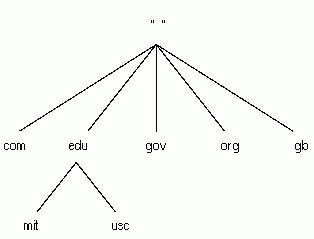DNS Names
The DCE naming environment supports the version of DNS that is based on Internet Request for Comments (RFC) 1034 and RFC 1035. Many networks currently use DNS primarily as a name service for host names. The most commonly used implementation of DNS is the Berkeley Internet Naming Domain (BIND). The BIND namespace is a hierarchical tree with its topmost levels under the control of the Network Information Center (NIC). (See OSF DCE Administration Guide - Introduction for information on how to contact the NIC Domain Registrar to register a domain name.)
The names directly under the root of the BIND namespace include two-letter codes for countries, such as us and gb, as defined in ISO Standard 3166, "Codes for the Representation of Names of Countries." Other names one level below the root include several generic administrative categories, such as com (commercial), edu (educational), gov (government), and org (other organizations). The owners of these names can grant permission to companies and organizations to create new subordinate names. The following figure shows a sample portion of the BIND namespace. (The double quotes indicate that the root of the namespace has a null name and is not addressable.) Note that, like CDS names, DNS names are not typed; that is, they do not consist of pairs of attribute types and values.
Sample Portion of the BIND Namespace

A DNS name consists of a string of hierarchical names that are separated by . (dots) and arranged right to left from the root of the namespace. For example, the name ai.mit.edu represents the branch of the namespace owned by the Massachusetts Institute of Technology artificial intelligence department. Note that the order of elements in the name is the reverse of the order for CDS and GDS names.
To use a DNS cell name as part of a global DCE name, specify the DNS name intact between two slashes. For example, a cell whose DNS name is ai.mit.edu might contain a directory whose CDS name is /.:/profiles. Users should enter /.../ai.mit.edu/profiles to refer to the directory by its global name.